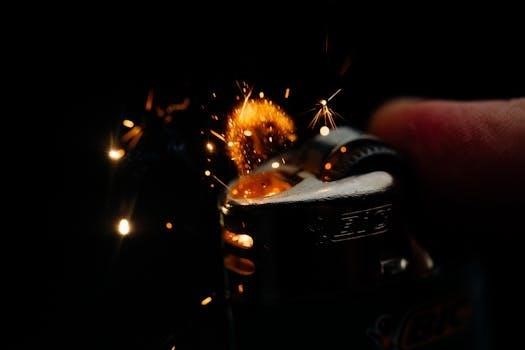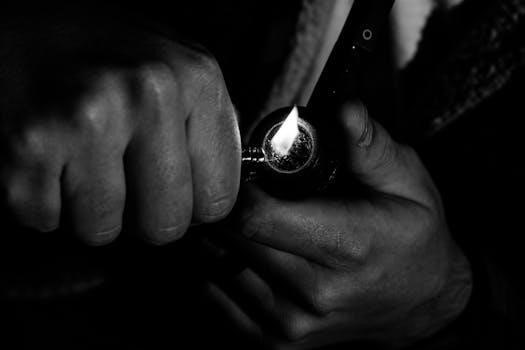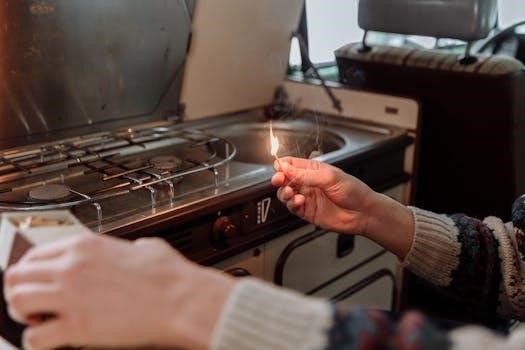Power Flame Burner Manual⁚ An Overview
This manual provides comprehensive information about Power Flame burners‚ which are known for their efficient combustion systems․ These burners are factory-tested‚ packaged units designed for accurate fuel-air ratio control․ The manual covers installation‚ operation‚ maintenance‚ and troubleshooting‚ ensuring optimal performance and safety․ It also includes details on specific models and their features․
Power Flame burners represent a sophisticated approach to combustion technology‚ designed for a wide array of commercial‚ industrial‚ and process applications․ These burners are engineered to provide precise control over fuel-air mixtures‚ ensuring both efficient and clean combustion․ They are renowned for their modular design‚ which simplifies maintenance and reduces long-term operating costs․ Power Flame burners are available in configurations for gas‚ oil‚ and combination fuel types‚ offering versatility for diverse operational needs․ The burners are factory-tested and delivered as completely packaged systems‚ streamlining the installation process and ensuring consistent performance from the outset․ Their advanced design facilitates controlled flame patterns‚ maximizing efficiency while minimizing emissions․ Moreover‚ these burners are built to accommodate various furnace pressures‚ making them suitable for multiple heating and process applications․ Power Flame’s commitment to innovation and environmental consciousness is evident in the design of their burners‚ which prioritize both performance and sustainability․ The company’s burners include features like flame safeguard systems‚ electric ignition‚ and prepurge cycles‚ enhancing safety and reliability․ The focus on modularity also means that components can be easily replaced‚ and the burner can be customized to the specific needs of the application․ The integration of combustion control systems further enhances the efficiency and responsiveness of the burners․
Key Features of Power Flame Burners
Power Flame burners are distinguished by several key features that contribute to their superior performance and reliability․ One notable aspect is their factory-tested‚ packaged design‚ which ensures a streamlined installation and consistent operation․ These burners incorporate precise fuel-air ratio control‚ allowing for optimal combustion efficiency across their firing range․ The modular construction of Power Flame burners is another critical feature‚ simplifying maintenance and reducing downtime․ This modularity also enables easy replacement of components‚ minimizing repair costs over the burner’s lifespan․ Many models come equipped with advanced flame safeguard systems‚ enhancing safety during operation․ The inclusion of electric ignition systems promotes reliable startup and reduces the risk of ignition failure․ Power Flame burners are also designed to produce controlled flame patterns‚ which are crucial for efficient heat transfer․ They are capable of operating with various fuel types‚ including natural gas‚ propane‚ and oil‚ providing flexibility for different energy sources․ Additionally‚ these burners often feature prepurge cycles‚ which further contribute to safe and dependable performance․ The integration of sophisticated combustion control systems is another key feature‚ allowing for precise adjustments and responsive operation․ These control systems help maintain optimal combustion conditions‚ ensuring that the burners operate efficiently and with minimal emissions․ The burners are engineered to withstand positive furnace pressures‚ making them versatile for multiple applications․

Understanding the C Burner Series
The Power Flame C Burner series represents a line of combustion systems known for their totally packaged and factory-tested design‚ offering a single point of responsibility․ These burners are engineered for accurate control of the fuel-air ratio throughout the firing range‚ leading to controlled flame patterns and clean combustion for maximum efficiency․ The C series is designed to be versatile‚ supporting various applications by firing natural gas‚ propane‚ and other approved waste gases․ Within this series‚ specific models like the CMax and Ultra CMax are tailored to meet diverse operational requirements‚ such as low NOx emissions and high turndown ratios․ A key element of the C series is its modular concept‚ which allows for lower initial investment costs and minimized maintenance expenses over the burner’s life․ The series also incorporates advanced flame safeguard systems‚ ensuring safe and reliable operation․ Furthermore‚ the C series often includes features like electric ignition‚ prepurge cycles‚ and ultraviolet or infrared flame detection for enhanced performance and safety․ The burners are designed to be easily installed and maintained‚ with components designated for easy identification․ The C series’ design also focuses on achieving high combustion efficiency‚ which results in lower fuel consumption and reduced environmental impact․ The adaptability of these burners to different operating conditions makes them a popular choice in various commercial and industrial applications‚ further supported by the comprehensive documentation and support provided by Power Flame․
Installation Procedures for Power Flame Burners
Installing a Power Flame burner requires careful adherence to the manufacturer’s guidelines to ensure safe and efficient operation․ Before beginning‚ it’s essential to uncrate the burner and verify all parts received against the provided sheets‚ noting any shortages or damages immediately with the carrier․ Components not mounted on the burner are typically designated with an “L” on the parts lists․ Prior to any work‚ turn off the power supply to the burner․ The burner should be installed by qualified personnel familiar with combustion systems and local codes․ Proper mounting of the burner to the boiler or heat exchanger is critical‚ ensuring a secure and sealed connection․ The installer’s packet includes vital documentation like a bill of materials‚ wiring and piping diagrams‚ and a recommended spare parts list‚ which should be referenced throughout the process․ Electrical connections must comply with the specifications in the manual and wiring diagrams․ Gas piping should be installed according to relevant standards‚ and a gas leak test performed after installation․ For models requiring special adapter plates‚ such as the V1122 and V1123‚ these must be used as specified․ After the mechanical and electrical connections are complete‚ a pre-start check must be conducted․ This check includes verifying the correct burner configuration for the fuel being used‚ ensuring all safety devices are functioning properly‚ and confirming the combustion air intake is clear․ Once satisfied with these preliminary checks‚ the burner can be started following the manufacturer’s instructions‚ including initial firing tests to monitor flame quality and stability․
Troubleshooting Common Issues
When troubleshooting Power Flame burners‚ it’s important to approach the process systematically․ Common issues often involve ignition problems‚ flame instability‚ or burner lockout․ If the burner fails to ignite‚ start by verifying the power supply and checking the fuse․ Consult the manual for specific error codes‚ as these provide vital clues about the nature of the problem․ Faulty components like ignition transformers‚ flame sensors‚ or gas valves can also lead to ignition failures․ A lazy or rolling flame‚ which indicates insufficient oxygen‚ may suggest blocked air intakes or flue obstructions․ Ensure the combustion air intake is free from debris and the flue above the inducer fan is clear․ Many units have a pressure switch that prevents ignition under insufficient draft conditions․ If the burner cycles on and off or experiences irregular operation‚ check the fuel supply for proper pressure and flow․ Look for loose wiring connections or damaged components․ In cases of repeated issues‚ ensure that the burner is properly matched to the system requirements‚ including the correct orifice size for the BTU input․ Refer to the burner’s manual for specific troubleshooting steps related to the error message․ If issues persist‚ it’s recommended to seek help from a qualified technician familiar with Power Flame burners․ Remember to turn off power before starting any troubleshooting steps․
Error Codes and Their Meanings
Power Flame burners utilize error codes to communicate specific issues‚ which can greatly aid in troubleshooting․ These codes are essential for diagnosing problems efficiently and effectively․ When an error code appears‚ it signifies a particular fault within the burner system that needs attention․ The burner’s manual is the primary resource for deciphering these codes․ Typically‚ error codes relate to problems with flame detection‚ ignition failures‚ gas valve malfunctions‚ or issues with the combustion air system․ For instance‚ a code might indicate a failure of the flame sensor to detect a stable flame‚ or a problem with the ignition transformer failing to generate a spark․ Other codes could point to low gas pressure‚ a blocked air intake‚ or even a problem with the control panel itself․ It is very important to consult your specific burner’s manual because the error codes and their meanings vary depending on the model and series․ Ignoring or misinterpreting these codes can lead to improper repairs and continued system failures․ Therefore‚ when an error code appears‚ immediately refer to the manual for the specific code definition and the recommended remediation steps․ Always note the exact code displayed‚ as this specificity can greatly narrow down the potential issues․ Understanding the error codes is a crucial skill for anyone working with Power Flame burners․
Maintenance and Periodic Checks
Regular maintenance and periodic checks are crucial for ensuring the optimal performance and longevity of Power Flame burners․ These procedures help to prevent potential issues and maintain a safe operating environment․ Maintenance should include regular inspections of the burner’s components‚ such as the ignition system‚ flame sensor‚ and gas valves․ It’s vital to check for any signs of wear‚ damage‚ or loose connections․ The air intake should be regularly inspected to ensure it’s free from blockages‚ which can affect combustion efficiency․ The flame appearance should also be observed; an irregular or lazy flame could indicate an issue needing correction․ Periodic checks should also include verifying the proper operation of safety devices‚ such as pressure switches and flame safeguards․ The linkage adjustments for modulation should also be checked regularly‚ ensuring they still align with factory settings․ It is important to follow the manufacturer’s recommendations and timelines for specific maintenance tasks․ A detailed checklist‚ as often provided in the manual‚ should be used to systematically go through all necessary checks․ Keeping a maintenance log is helpful to track when tasks were performed and any observations made․ Furthermore‚ any component that is found to be faulty or damaged should be replaced immediately․ This proactive approach can significantly reduce the risk of unexpected downtime and expensive repairs․
Start-up and Test Data Record
The start-up process for Power Flame burners is a critical phase that must be performed carefully and systematically․ Before initiating the burner‚ all electrical connections and gas lines must be checked for proper installation and tightness․ The burner should be thoroughly inspected for any loose parts or damage that may have occurred during shipping or installation․ The initial start-up should follow the procedures outlined in the manual step-by-step‚ ensuring each control and safety device is functioning correctly․ This involves verifying the pre-purge cycle‚ the ignition sequence‚ and the flame detection system․ After the burner is ignited‚ the flame appearance should be closely observed․ It should be stable‚ with the correct color and shape․ Any irregularities‚ like a lazy or unstable flame‚ must be addressed before proceeding․ Following the start-up‚ a comprehensive test data record should be maintained․ This record should include details of the initial flame appearance‚ gas pressure readings‚ and any adjustments made to air or fuel ratios․ The burner’s performance should be evaluated at various firing rates to ensure it operates efficiently and safely․ This data provides a baseline for future maintenance and troubleshooting․ It should also include the date of the start-up‚ the model and serial number of the burner‚ and the name of the person conducting the start-up․ By keeping thorough records‚ you can track changes in burner performance over time‚ which allows you to detect problems early․ The test data record is a valuable tool for maintaining optimal operation and addressing any issues that arise․

Modulation and Linkage Adjustments
Modulation and linkage adjustments are vital for ensuring efficient and reliable operation of Power Flame burners․ Modulation refers to the burner’s ability to vary its firing rate based on the system’s demand‚ optimizing energy consumption and reducing cycling․ Proper linkage adjustments are essential to maintain the correct air-fuel ratio throughout the modulation range․ These adjustments involve the mechanical connections between the burner’s air and fuel controls․ Incorrect settings can lead to incomplete combustion‚ resulting in wasted fuel and potential safety hazards․ The manual provides detailed instructions on how to calibrate and adjust the linkages to achieve the proper air-fuel ratio at all firing rates․ During the adjustment process‚ the burner should be closely monitored to observe flame characteristics at different modulation levels․ The flame should remain stable and efficient‚ without any signs of incomplete combustion‚ such as soot or excessive emissions․ Adjustments should be made gradually‚ with careful recording of each change and its effect on burner performance․ It is also important to check the burner’s response to load changes and ensure it modulates smoothly without excessive lag or overshoot․ These adjustments are crucial for maximizing the burner’s efficiency and minimizing wear on components․ Factory settings for linkage adjustments are often a good starting point‚ however‚ fine-tuning based on system requirements and fuel characteristics is crucial․ A properly adjusted burner will not only save energy but also ensure safe and consistent operation throughout its lifespan;

Safety Precautions and Warnings
Safety is paramount when dealing with Power Flame burners‚ and strict adherence to safety precautions and warnings is crucial to prevent accidents‚ injury‚ or property damage․ Always begin by thoroughly reading the manual before attempting any installation‚ operation‚ maintenance‚ or troubleshooting․ Prior to working on the burner‚ ensure the power supply is completely turned off and locked out to prevent accidental startup․ Never store or use flammable liquids or vapors near the burner or any other appliance․ Any modification or alteration to the burner without authorization can cause serious harm and will void the warranty; If a gas leak is suspected‚ immediately extinguish any open flames‚ do not operate any electrical switches‚ and contact your gas supplier․ Always ensure that the burner is properly grounded to avoid electrical shock hazards․ When working on the burner‚ always wear appropriate personal protective equipment‚ such as safety glasses and gloves․ Avoid direct contact with hot surfaces․ If any component is faulty‚ it must be replaced with an approved part; Improper installation‚ adjustment‚ or maintenance can result in dangerous conditions․ Be aware of the potential for carbon monoxide poisoning and make sure the area is properly ventilated․ Follow the proper start-up procedures provided in the manual․ Regular inspection and maintenance are crucial to identify and correct any potential safety issues․ If in doubt‚ always consult a qualified technician․ Remember‚ safety is not an option‚ it is a necessity․
